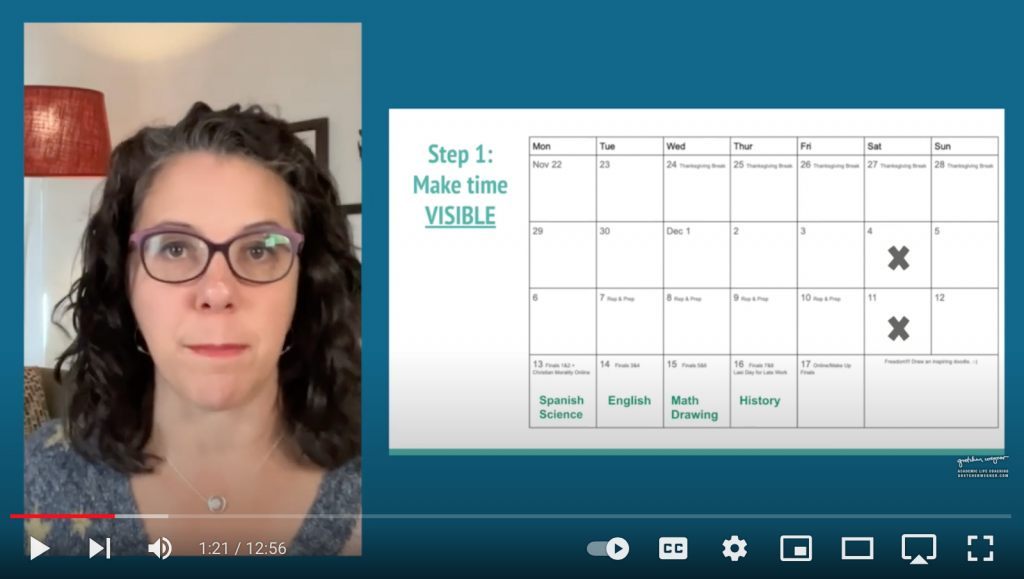In the U.S. right now, it’s final exam season, and I know you are not going to wait until the last minute to study, right students? And teachers, I know you’re not going to wait until the last minute to tell students–generally speaking–what’s going to be on the final exam right, right? And we’re not gonna do this because we know how to make anti-cram plans, right? Well, if you stick with me today, you’re gonna know how to make an anti-cram plan!
Alrighty, there are five steps to making an anti-cram plan, so I’m going to talk to students first and walk you all through those five steps. And then, educators, teachers, and coaches, please read all the way until the very end, which is when I’m going to walk you through how you can support your students in making an anti-cram plan.
The 5 Steps to Make an Anti-Cram Plan
- Make Time Visible.
Too many students whom I coach don’t really have a sense about how long it is until final exams. Three to four weeks before finals, what I like to do is make a one-page Making Time Visible Chart. The chart needs to show where am I today, when is my final exam happening, and how many days or weeks are there between today and the actual final exam.
It’s actually quite important that it’s on one page because we want to see it in the blink of an eye. It follows what I like to call in my time-management processes and my Anti-Boring Approach “the one blink test.” Often when students see it all on one page, they say, “oh my God, I didn’t know finals are so soon!” or “oh goodness, actually I have a bit more time to study than I thought, so I should get on it!” Either way, seeing it on one page helps students better understand what they’re working with.

- Prioritize Your Classes By Difficulty
The truth is that no student has time to actually study for every test in every class perfectly–it’s just not reality, unless you start way in advance. So go ahead and know which are my hardest classes that I’m going to need to be the most mindful about studying for. Then, at least put those classes on your anti-cram plan. Some students feel too overwhelmed when they put all their classes on the plan–which is one reason why I like to say start by making your anti-cram plan for your most difficult one or two classes … and then you can go back and decide if you want to layer in the other classes that might be a bit easier for you to pass.
- Organize Your Study Resources
This is such a big topic that I’m actually going to make a whole ‘nother video & post all about how to organize your study resources, so stay tuned for that, but for now just know that it can be really useful to put time on your calendar and to simply organize your study tools because it’s an easier way to start studying than to actually start studying. In the United States, Thanksgiving week is an ideal time to go through your binders to look for old tests and quizzes, flash cards you’ve made, and objectives that help you know how to study or study guides for past tests that teachers may have given you…and put everything in one place. Then, when you’re ready to start studying in earnest, you have the tools you need and you know where to find them.
- Schedule Time to Practice Retrieval
Step number four is to schedule time to retrieve or to practice retrieval. If you don’t know what that means, you might want to download my free guide about the three-step Study Cycle. That will tell you much more information about what I mean by the word retrieval. For now, all you need to know is that it means time to test yourself to see what you know and what you don’t know. For example, it can be a really good idea to put on your calendar when you’re going to go through all of your flash cards from a language class, and just see where you are with all the words. Make a pile of what you seem to know and a pile of what I seem not to know.
Too many students end up taking time studying stuff they already know, so if you put time to retrieve on your calendar earlier on in your study process, that’s a a really good thing to do because it might lessen the amount of actual learning time you need to put into your study plan.
- Schedule Time to Encode in a New Way
Again, if you don’t know what “encode” means, it is a crucial step in my three-step Study Cycle so grab that here. For now, what this means is to teach yourself the stuff you haven’t learned yet. That’s the simple way of understanding encoding in a new way, so it’s important to schedule time for that.
My favorite way to encode when I was in high school in the ‘80s was I had a big blackboard that I would fill with little pictures of the words or the concepts that I didn’t understand and drawing arrows between them. I’m not saying you need to do that exactly but that was encoding in a new way to me. If you are familiar with my Anti-Boring Approach to Powerful Studying, this is a great time to use all your study senses in order to try and learn the information that you’re having trouble remembering with a lot of variation, so it’s not boring.
Now you know all five of the steps to making an anti-cram plan! I recommend that you start right now. Don’t just think, “okay, I’m done.” Right now, get yourself out a piece of paper. Draw out a rectangle, then put the lines in that rectangle so you can see how many weeks you have, and sketch out “a shitty first draft” of your anti-cram plan, and just see what that feels like to try that right now, students.
Alrighty, teachers, it’s your turn!
There is a lot teachers can do to help students be able to understand how to prepare themselves and how to think Big Picture about how to study for their finals. One would be to pass out a one-page calendar like I discussed above three to four weeks ahead of finals. I know many teachers don’t even start talking to students about final exams until the week before finals. That, in my opinion as an academic coach, is way too late. I get it, though. Teachers are as overworked as students are, so sometimes you just can’t get to thinking ahead about it. But if you can, get them thinking about this–even if you don’t know exactly what’s going to be on the final exam yet–by passing out a calendar for them to fill in three to four weeks before so they can start seeing how soon finals are are coming.
The next thing is to help students organize the quizzable study tools from your class. Ideally this would be something you would be doing all semester long. Old tests, old quizzes, even homework assignments–there are lots of ways you can make sure that the assignments you’re giving students are quizzable. What I mean by “quizzable” is it is a resource with which students can look at the question, test themselves to see if they know it or don’t know it, and then see the answer so they can successfully assess themselves. So, help them organize these things; maybe even give them class time to look through their binders and organize them or even organize their computer desktops if you use any technology in your classroom. This can be a wonderful way to orient students. Then as you get closer to exams, you can provide in-class opportunities to retrieve and encode. I love it when teachers teach students these words and what they mean, and the way you do that is to learn the Study Cycle and then teach it to students. My course The Art of Inspiring Students to Study Strategically is designed to help teachers–using tiny, ten-minute mini-lectures–teach students about all the brain theory related to how great learning happens. My ideal would be for teachers to really know how to easily incorporate brain science and these kinds of specific strategies into their curriculum. For now though, if that’s not you yet, at least provide your students opportunities to test themselves. You could encourage them to make a list of the things they discover they don’t yet know so they can study those in a new way. Maybe have a whole class right before finals dedicated to encoding in a new way together. Ask students, “what are the things you don’t know yet” and then coach them to ask each other, ask you, draw silly pictures, or make up songs.
Teachers, the more you can incorporate these strategies and also tell students why you are incorporating these strategies (which is, by the way, to help model what they can do when they’re on their own during study time), the better you’re able to help students whose executive functions haven’t fully formed yet be able to practice strategies so they can do them on their own. It will be such a gift to them. Thank you in advance for giving them this gift!
That wraps up today’s discussion of how to plan for studying for finals. And, just a reminder, whether you’re a student or a teacher, if you have questions about any of this, I am available to talk with you during my free, monthly office hours. Sign up here and please come ask study questions, any questions you have about the contents of my videos or how we can de-stressify school in anti-boring ways. If you’re an educator who is thinking, “Hmm…I might like to start my own business as an academic life coach, I have a whole training all about how you can transition from teaching to coaching, maybe as a side gig or maybe as your full-time gig. At my live office hours on December 13, I will give you a behind the scenes view about what it looks like to have an academic coaching business and teach you five simple steps to finding your first paid clients.
Happy Anti-Cram Planning!

